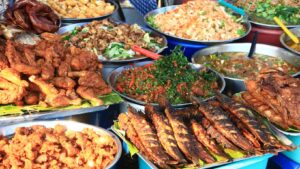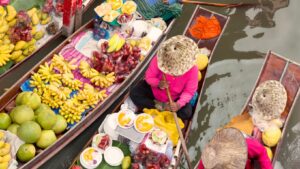Thailand’s food culture is a vibrant symphony of flavors, colors, and textures that captivates the senses. It’s a culinary journey that goes beyond just eating, it’s an integral part of the Thai way of life. From bustling street markets to high-end restaurants, food is at the heart of Thailand’s social fabric.
Each region boasts its unique dishes, with ingredients that tell a tale of the land’s bounty and the people’s ingenuity. The balance of sweet, spicy, sour, and salty is the defining characteristic of Thai cuisine, creating a harmonious blend that’s loved worldwide. Dive into this article to explore the rich and diverse world of Thailand’s food culture.
Thailand Food Culture
The Role of Fresh Ingredients
A keystone in Thailand’s culinary scene lies in its use of fresh ingredients. The country’s tropical climate contributes to an abundant supply of fruits, vegetables, herbs, and spices that are integral components of Thai cuisine. In soups like Tom Yum, lemongrass, kaffir lime leaves, and galangal play starring roles, adding a tangy zest. Similarly, dishes such as Papaya Salad showcase the freshness of locally-sourced produce, expertly balancing fiery chilies with the sweetness of papaya.
Prominence is also given to proteins like prawns, chicken, and pork. Snapper fish, celebrated for its tender meat, lends its richness to fish curry, a familiar sight in Southern Thai menus. Furthermore, coconut milk, extracted fresh from grated coconuts, serves as the creamy base of curries and desserts alike, demonstrating the crucial role of fresh ingredients in the diverse Thai food culture.
Street Food: A Cultural Phenomenon
Street food, ubiquitous across Thailand, forms a crucial part of the nation’s culinary culture. Bangkok’s bustling streets transform into gastronomic hubs, with vendors serving up delectable delights round-the-clock. From the flame-grilled Satay skewers at Chinatown’s Yaowarat road to the crispy Phad Thai prepared at Thipsamai’s, street food in Thailand offers a culinary experience unlike any other.
Not only does street food provide an affordable meal option, but it’s also a culinary divining rod, guiding locals and tourists alike through a multitude of flavors that characterize the nation’s cuisine. The accessibility and sheer variety of street food make it a cultural phenomenon, revealing Thailand’s food culture one bite at a time.
Traditional Thai Meals and Eating Customs
The Communal Nature of Thai Eating
Thai eating culture exhibits a strong communal nature, a trait giving rise to an array of shared dishes during meals. Long-held traditions endorse the practice of sharing, exemplified by communal meals showing buckets of steamed jasmine rice accompanied by multiple dishes. Curries, soups, and fresh vegetable offerings, for instance, allow diners to customise their plates according to personal tastes. Similarly, Thai tables frequently celebrate the country’s rich seafood tradition, offering dishes such as fish grilled whole or stir-fry dishes mixed with shellfish. The act of sharing brings a sense of community, binding together through the universal language of food.
Typical Meal Structure in Thailand
In terms of meal structure, Thailand distinguishes little difference between breakfast, lunch, and dinner. The Thais, known for their hearty appetite, traditionally consume up to five small meals in a single day. Their meals typically kick-off with a staple food like rice, forming the base of their meal.
The Spice Profile of Thai Cuisine
Thailand’s food culture is a vibrant tapestry woven with fresh ingredients, balanced flavors, and communal dining. It’s a culture that thrives on the streets, in homes, and in the hearts of those who relish the country’s diverse culinary offerings. Thai meals, with their lack of distinction between breakfast, lunch, and dinner, reflect a lifestyle where food is not just sustenance but an integral part of daily life. The typical Thai meal, starting with rice and accompanied by a symphony of proteins, vegetables, and sauces, is a testament to the harmony and diversity inherent in Thai cuisine. Each region boasts its unique dishes, with ingredients that tell a tale of the land’s bounty and the people’s ingenuity. The balance of sweet, spicy, sour, and salty is the defining characteristic of Thai cuisine, creating a harmonious blend that’s loved worldwide. Dive into this article to explore the rich and diverse world of Thailand’s food culture.



